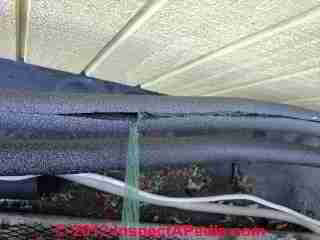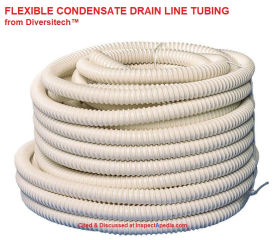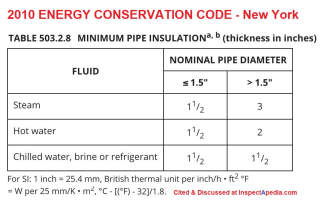 Insulation Requirements for HVACR Condensate Drains
Insulation Requirements for HVACR Condensate Drains
Is insulation required on the condensate drain pipe?
- POST a QUESTION or COMMENT about condensation problems on A/C or refrigeration condensate drain pipes or lines
This article discusses the requirements, or lack thereof, for insulation on condensate drain piping used to dispose of water condensate from air conditioning, heat pump and refrigeration or dehumidifier systems.
Above: a pipe insulation table from the New York 2010 Energy Code. This table and code do not state a requirement for condensate pipe insulation but be sure to read details given in the article below.
InspectAPedia tolerates no conflicts of interest. We have no relationship with advertisers, products, or services discussed at this website.
- Daniel Friedman, Publisher/Editor/Author - See WHO ARE WE?
Condensate Drain Insulation Requirements & Codes
 The model building codes do not explicitly require insulation on HVACR condensate drain piping, but in some circumstances that insulation might still be recommended or even required by a local code official.
The model building codes do not explicitly require insulation on HVACR condensate drain piping, but in some circumstances that insulation might still be recommended or even required by a local code official.
Reader Question: does the condensation line of an attic HVAC unit need to be insulated?
7 Feb 2015 Diane S said:
In SC, does the condensation line of an attic HVAC unit need to be insulated?
Reply: No.
Diane, If your condensate line is not leaking but you are seeing condensation on its exterior such that the exterior moisture is enough to cause damage, then as good condensate drain installation practice that means you would insulate the line.
Model codes don't require that the A/C condensate drain line to be insulated. Some home inspectors and HVACR technicians want the drain to be insulated either to cure an actual observed wetting problem OR because they're making their own, probably unnecessary, interpretation of one of the model energy codes.
- See ANSI/ASHRAE/IES Standard 90.1-2010 & 2012 IECC, "Insulation Requirements in Commercial Buildings for Mechanical and Service Hot-Water Piping"
- ASHRAE Standard 90.1-2010, Section 6.4.4.1 HVAC System Pipe Insulation, lists HVAC piping requirements and as an EXCEPTION,
excludes from that requirement
"Piping that conveys fluids that have not been heated or cooled through the use of fossil fuels or electricity (such as roof and condensate drains, domestic cold water supply, and natural gas piping)" - retrieved 2/9/2015 original source www.energycodes.gov
This Q&A were posted originally
Question: requirement to insulate A/C condensate drains in Texas?
2021/06/03 Amy - any information on condensate drain insulation requirements?
My company recently changed out all the hvac equipment at an apartment complex.
The complex is now owned by a new owner and he has contacted us about why we didn't insulate the condensate drain lines that are inside the return air in an air conditioned space.
We live in Texas and I can't find a clear answer on if that is required or not. Does anyone have any information about this topic?
Moderator reply: no code requirement; some situation requirements, local code official rulings
@Amy,
We are discussing good practice in HVACR installation: materials, routing, and possible need for insulation on the condensate drain line.
First: Is there a Building Code Requirement for Condensate Drain Piping Insulation?
No. Building & mechanical codes do not require insulation on A/C condensate drains, based on a reading of the current U.S. Energy Code that I will excerpt here. You'll see that in Texas there is not much chance that the condensate drain is going to be running at the operating temperature ranges ( 105°F (40°C) or below 55°F ) cited here.
Be sure to take note of the EXCEPTIONS in the code citation below.
N1103.3 Mechanical system piping insulation.
Mechanical system piping capable of carrying fluids above 105°F (40°C) or below 55°F (13°C) shall be insulated to a minimum of R-3.
Energy code: Section 503.2.8 Piping insulation.
All piping serving as part of a heating or cooling system shall be thermally insulated in accordance with Table 503.2.8. (this is a table of insulation thicknesses that I will post below)
Exceptions:
1. Factory-installed piping within HVAC equipment tested and rated in accordance with a test procedure referenced by this code.
2. Factory-installed piping within room fan-coils and unit ventilators tested and rated according to AHRI 440 (except that the sampling and variation provisions of Section 6.5 shall not apply) and 840, respectively.
3. Piping that conveys fluids that have a design operating temperature range between 55°F (13°C) and 105°F (41°C).
4. Piping that conveys fluids that have not been heated or cooled through the use of fossil fuels or electric power.
5. Runout piping not exceeding 4 feet (1219 mm) in length and 1 inch (25 mm) in diameter between the control valve and HVAC coil.
In my OPINION citing "code" is a weak argument for not addressing a condensate handling problem **IF** the problem is present or likely and considering that we don't find that requirement in the model codes.
Watch out: Your local building code compliance officer is the final legal authority on this question.
If she didn't require insulation at the time the work was performed, a retrofit insulation ought not be required on the condensate drain line either UNLESS a problem is being observed.
Next: Is there a problem of condensate forming on the outside of a condensate drain line at your installation?
Before we worry too much let's find out if there is a concern, that is, is there actually a problem of condensate forming on the outside of the condensate drain line and in sufficient quantity to wet the interior of the return ducts (which isn't a great place to rout pipes of any sort).
Ask the new owner to be more-specific about any damage or problem conditions she's seeing - maybe send along a photo.
It's possible that the owner has got a report from an inspector who, under the aegis of being through, reported this condition as a concern or possible concern
. If that's the case the owner ought to have had that information before the sale was completed. So do let me know if you can find out this detail.
When Might Condensate Form on the Outside of a Condensate Drain Pipe?
A/C condensate water is cool to chilly;
The return air flowing through return ducts into an A/C air handler may be high in moisture.
Depending on the actual RH and temperatures involved (and some other factors), that combination may result in sufficient water condensing on the outside of the condensate drain line in that space to cause dripping, wetting, inside the return ducts.
The result can be wet, moldy A/C insulation, increasing A/C operating cost and leading to a costly mold cleanup and duct re-insulating job.
What is the Risk of Condensate on the Outside of a Condensate Drain Line?
The level of risk of condensate forming on the outside of the AC condensate drain line routed through occupied space or through the return duct depends on
- The condensate line material: Sch. 40 PVC piping is a good insulator, reducing the risk of condensate formation on the outside of the drain (added insulation might not be needed)
- The RH or temperature and humidity in the ducts or other areas through which the condensate drain has been routed
- The material around the condensate drain and the probability that that material could, if wet, become any of the problems I've cited.
- See details
at CONDENSATE LEAKS and
at CONDENSATION or SWEATING PIPES, TANKS
Bottom line: insulation recommendations on HVACR Condensate Drain Piping
- The model building codes such as the Mechanical Code do not explicitly require condensate drain line insulation;
- Some home & building inspection guidelines recommend reporting as a defect insulation missing on both the refrigerant piping and on the condensate drain line.
On this point I recommend reading
OTHER PEOPLE's MONEY ... well maybe if there's a problem, else perhaps we're going a bit far = OPINION - Insulating the condensate drain line is not common anywhere, but in my OPINION would be good practice IF the installer has found such installations in her area collecting and dripping-off external condensate into the surroundings.
- Some local, state, or provincial mechanical codes or inspectors may require insulation on the condensate drain line, particularly where it runs horizontally through conditioned spaces or ducts;
- IF the manufacturer's installation instructions OR the local building code compliance officer require insulation on the condensate drain line, do it and don't waste another minute arguing the point.
If Insulation is Needed on a Condensate Drain, at What Thickness?
Above: Table 503.2.8 Minimum Pipe Insulation Thickness, adapted from the 2010 New York State Energy Conservation Code.
[Click to enlarge any image]
Where pipe insulation is required the requirement depends on pipe size, use, and temperatures that will be encountered
Using California's Title 24 as a good example, see the table below.
Really? The tables of pipe insulation shown here are interesting in that each gives insulation thickness required in inches without specifying the insulation material though Table 503.2.8 does give an assumed R-value per inch of insulation.
See also INSULATION R-VALUES & PROPERTIES
[Click to enlarge any image]
...
Continue reading at CONDENSATE DRAINS, CODES or select a topic from the closely-related articles below, or see the complete ARTICLE INDEX.
Or see these
HVAC Condensate Articles
- BUILDING CODE DOWNLOADS - free downloadable PDF files of building codes & standards
- CONDENSATE HANDLING, HVAC - home
- CONDENSATE LEAKS
- CONDENSATE PUMPS
- CONDENSATE DISPOSAL, IMPROPER
- CONDENSATE DRAINS, CODES
- CONDENSATE DRAIN CLEAN & DE-CLOG
- CONDENSATE DRAIN INSULATION REQUIREMENTS
- CONDENSATE DRAIN PROBLEMS
- CONDENSATE DRIP TRAY DEFECTS
- CONDENSATE PAN SWITCH LOCKOUT
- Legionella BACTERIA & HVAC EQUIPMENT
- CONDENSING BOILER/FURNACE CONDENSATE DRAIN
- DUCT SYSTEM DESIGN SIZE & DEFECTS - home
- REFRIGERANT PIPING INSULATION
- WATER & ICE IN DUCT WORK
- WET CORRODED DUCT WORK
Suggested citation for this web page
CONDENSATE DRAIN INSULATION REQUIREMENTS at InspectApedia.com - online encyclopedia of building & environmental inspection, testing, diagnosis, repair, & problem prevention advice.
Or see this
INDEX to RELATED ARTICLES: ARTICLE INDEX to AIR CONDITIONING & HEAT PUMPS
Or use the SEARCH BOX found below to Ask a Question or Search InspectApedia
Ask a Question or Search InspectApedia
Try the search box just below, or if you prefer, post a question or comment in the Comments box below and we will respond promptly.
Search the InspectApedia website
Note: appearance of your Comment below may be delayed: if your comment contains an image, photograph, web link, or text that looks to the software as if it might be a web link, your posting will appear after it has been approved by a moderator. Apologies for the delay.
Only one image can be added per comment but you can post as many comments, and therefore images, as you like.
You will not receive a notification when a response to your question has been posted.
Please bookmark this page to make it easy for you to check back for our response.
IF above you see "Comment Form is loading comments..." then COMMENT BOX - countable.ca / bawkbox.com IS NOT WORKING.
In any case you are welcome to send an email directly to us at InspectApedia.com at editor@inspectApedia.com
We'll reply to you directly. Please help us help you by noting, in your email, the URL of the InspectApedia page where you wanted to comment.
Citations & References
In addition to any citations in the article above, a full list is available on request.
- In addition to citations & references found in this article, see the research citations given at the end of the related articles found at our suggested
CONTINUE READING or RECOMMENDED ARTICLES.
- Carson, Dunlop & Associates Ltd., 120 Carlton Street Suite 407, Toronto ON M5A 4K2. Tel: (416) 964-9415 1-800-268-7070 Email: info@carsondunlop.com. Alan Carson is a past president of ASHI, the American Society of Home Inspectors.
Thanks to Alan Carson and Bob Dunlop, for permission for InspectAPedia to use text excerpts from The HOME REFERENCE BOOK - the Encyclopedia of Homes and to use illustrations from The ILLUSTRATED HOME .
Carson Dunlop Associates provides extensive home inspection education and report writing material. In gratitude we provide links to tsome Carson Dunlop Associates products and services.



